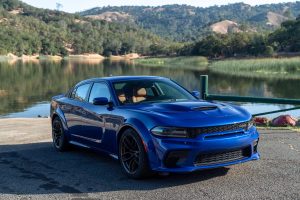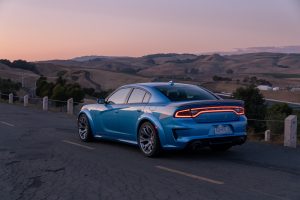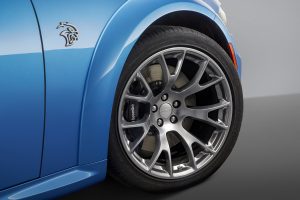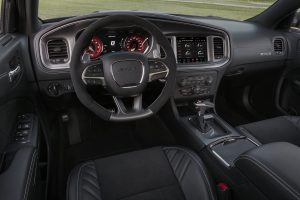 At a time when some automakers are giving up on sedans or least pushing their SUVs/crossovers to buyers seeking family transportation, Dodge seems to be taking a different approach.
At a time when some automakers are giving up on sedans or least pushing their SUVs/crossovers to buyers seeking family transportation, Dodge seems to be taking a different approach.
Since bringing back its famed Charger as a 2006 five-passenger large sedan after killing off the coupe version in 1987, the automaker has expanded the Charger portfolio from two versions (SE and R/T) to five trim levels for 2020 with the outrageous 707-horsepower SRT Hellcat sitting at the top of the class.
And it is getting some upgrades for 2020. A new Widebody Package that is standard on the Hellcat and available on the Scat Pack trim features new front and rear fascias with integrated fender flares that add 3.5 inches of width over the wider wheels and tires (Hence the “Widebody” tag.).
 That provides more room for 20- by 11-inch wheels that are shod with wider and stickier Pirelli 305/35ZR20 tires than were on its predecessor. Dodge trumpets that that combination, “paired with new competition suspension tuning with Bilstein three-mode adaptive damping, produces even more grip, delivering improved performance on the street, strip and road course, making this the quickest and best handling production Dodge Charger SRT Hellcat ever.”
That provides more room for 20- by 11-inch wheels that are shod with wider and stickier Pirelli 305/35ZR20 tires than were on its predecessor. Dodge trumpets that that combination, “paired with new competition suspension tuning with Bilstein three-mode adaptive damping, produces even more grip, delivering improved performance on the street, strip and road course, making this the quickest and best handling production Dodge Charger SRT Hellcat ever.”
As if 707 horsepower isn’t enough, the 6.2-liter HEMI V8 in limited production Daytona 50th Anniversary Edition models get a boost to 717 hp with torque at 650 pound-feet.
Dodge says that the 2020 Charger SRT Hellcat — the “SRT” stands for “street racing technology” — is the “the quickest and best-handling production Dodge Charger SRT Hellcat ever.”
 As evidence, how about a zero-to-60 mph time of 3.6 seconds, quarter mile in 10.96, and .96g lateral grip on the skid pad.
As evidence, how about a zero-to-60 mph time of 3.6 seconds, quarter mile in 10.96, and .96g lateral grip on the skid pad.
The 8-speed manual transmission offers manual gear selection via steering wheel-mounted paddle shifters. Drive Modes are pre-configured for Sport, Track and Default settings, and Custom Mode lets the driver select their preferred settings.
Charger SRTs come with rear-wheel drive as standard. All-wheel drive is available on some other Charger models.
Even with the emphasis on performance, the Charger SRT Hellcat is civilized enough to seat five passengers comfortably with 40.1 inches of legroom, 57.9 inches of shoulder room, and 36.6 of headroom in the back.
 The seats are comfortable providing for a smooth ride experience, but with the rumbling exhaust, it is anything but quiet. Ventilated Laguna leather seats with the Hellcat logo are standard on the SRT Hellcat and come in black, black/sepia, black/demonic red colors.
The seats are comfortable providing for a smooth ride experience, but with the rumbling exhaust, it is anything but quiet. Ventilated Laguna leather seats with the Hellcat logo are standard on the SRT Hellcat and come in black, black/sepia, black/demonic red colors.
The cabin probably isn’t as refined as you will find in luxury sedans with their genuine wood and brushed aluminum inlays, but it’s not the bleak, spartan interior typical of past Muscle Cars either. It would be nice, perhaps, if there were a bit fewer hard plastic surfaces.
The UConnect 4C infotainment system on the SRT Hellcat is one of the friendliest around and features a nice-sized 8.4-inch touchscreen display screen as well as knobs for operating such basic functions as audio adjustments and climate control. Apple CarPlay, Android Auto, and satellite radio are included.
Also available is an upgraded UConnect 4C system with navigation.
 Pricing for the Charger SRT Hellcat Widebody starts at $71,140 or more than double the $31,359 for the base Charger SXT. Both numbers include a hefty $1,495 destination and delivery charge, and the SRT Hellcat also is levied a $2,100 gas guzzler fee.
Pricing for the Charger SRT Hellcat Widebody starts at $71,140 or more than double the $31,359 for the base Charger SXT. Both numbers include a hefty $1,495 destination and delivery charge, and the SRT Hellcat also is levied a $2,100 gas guzzler fee.
The bottom line on my test vehicle was $78,320.
What I liked about the 2020 Dodge Charger SRT Hellcat Widebody: Infotainment features are very user-friendly, and the display screen is of good-size. Obviously, the power is something to enjoy, and the interior is roomy. So is the trunk.
What I didn’t like about the 2020 Dodge Charger SRT Hellcat Widebody: Fuel mileage, as expected, is very poor. Premium fuel is required for the Hellcat, and EPA mileage figures are among the lowest I’ve seen in a while at 12 miles-per-gallon city, 21 highway, and 15 combined. Numbers from the computer readout on my test vehicle stayed mostly at 11-12 mpg and change and barely touched 13.
Would I buy the 2020 Dodge Charger SRT Hellcat Widebody? Mixed feelings here. I’d love to have one, but it’s not a great everyday vehicle for sure. Finding a spot where you can “stretch its legs” to full performance is virtually impossible outside the race track. But if you can afford a $70,000 toy, you won’t be disappointed.
*Photos furnished by FCA






